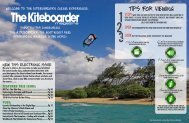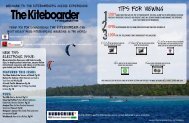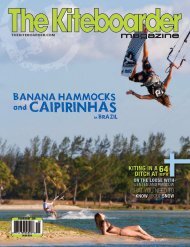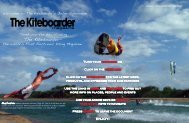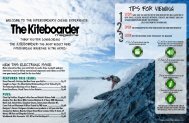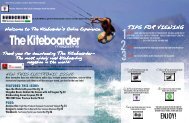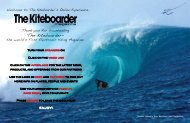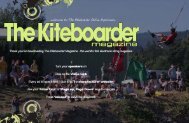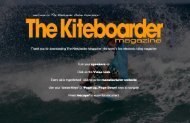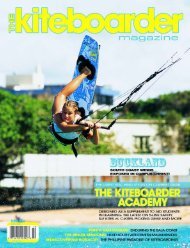TIPS FOR VIEWING - The Kiteboarder Magazine
TIPS FOR VIEWING - The Kiteboarder Magazine
TIPS FOR VIEWING - The Kiteboarder Magazine
You also want an ePaper? Increase the reach of your titles
YUMPU automatically turns print PDFs into web optimized ePapers that Google loves.
40 thekiteboarder.com<br />
It was hard to convince Ian Alldredge to come back to Indonesia after being skunked last<br />
year, but the incredible conditions on this trip made his return more than worthwhile.<br />
30 thekiteboarder.com<br />
Ben Wilson doesn’t usually ride Zach with Kleppe straps, entertains but with the the crowd Fastrack with system, a particularly he can good quickly wipeout. install<br />
straps to just the spot he wants in seconds. Photo Jason Wolcott<br />
Skyline, Utah offers 100 miles of terrain for every level of rider.<br />
Photo Gustav Schmiege<br />
Densely populated areas seem to be experiencing the majority of<br />
multi-use challenges. Photo Katina Arnott<br />
With the Fastrack system, you can fine tune your strap positions to suit your<br />
style or the conditions. Photo Jason Wolcott<br />
On the Darko, the first<br />
Slingshot twin-tip to be<br />
equipped with Fastrack, you<br />
will be able dial in the exact<br />
stance you want anywhere between<br />
20-26”. Photo Courtesy Slingshot<br />
thekiteboarder.com 41<br />
By Reo Stevens | Photos by Jason Wolcott<br />
thekiteboarder.com 31<br />
Proving that powered-up unhooked riding isn’t just for the young guns, Australian ripper Richard<br />
Milne pushes himself harder than most – and is more than 40 years old. Photo Jennifer Milne<br />
Features<br />
launch<br />
In the traditional system, a pack of threaded inserts set in<br />
foam or plastic are installed into the core of the board<br />
and then glassed over. This system has worked well over<br />
the years, but the big disadvantage is that you are at the<br />
mercy of the manufacturer for your choices of strap or<br />
binding placement. Slingshot Kiteboarding has recently<br />
come up with a new system of attaching straps to boards<br />
to solve this problem. Known as Fastrack, this new<br />
system looks similar to a mast track on a windsurf board,<br />
and allows the rider to dial in their stance to their exact<br />
preference. According to Tony Logosz at Slingshot, “Burton<br />
put a similar system in snowboards which was accepted<br />
and liked. When we started prototyping the idea, we didn’t<br />
come across any negatives, only positives, so we pursued<br />
further development. We’ve been testing the system for<br />
over a year now.”<br />
According to Slingshot, the new Fastrack system offers<br />
many benefits over the traditional system and is currently<br />
available on Slingshot’s line of Aviso surfboards. Slingshot<br />
will also integrate Fastrack into some 2010 boards including<br />
the new Darko twin tip, with both options available<br />
(Fastrack and non-Fastrack boards) on select 2011 models.<br />
According to Logosz, Fastrack allows riders to adjust their<br />
stance anywhere within a 20”-26” range, instead of in 1”<br />
increments like the current systems .He claims that boards<br />
utilizing Fastrack are lighter and stronger due to the lack<br />
of insert packs and an improved load distribution. Not only<br />
can your strap placement be much more adjustable with<br />
the Fastrack, but you can change your straps or remove<br />
them in less than five seconds. “Instead of industry set<br />
systems, especially on surfboards, now riders can set straps<br />
exactly to their sweet spot and personal preference and<br />
change quickly to adjust for different conditions or other<br />
riders,” said Logosz. “Now you can make your twin tip more<br />
directional-like by bringing your back foot back, allowing<br />
you to throw big spray like a directional.”<br />
fastrack:<br />
By Marina Chang<br />
12 Fastrack: <strong>The</strong> Next One Pump?<br />
Slingshot’s the next innovative one pump? new footpad and strap system.<br />
By Paul Lang<br />
Over the past 10 years, most of the equipment we use<br />
as kiteboarders has gone through major design changes,<br />
each time becoming more refined and easier to use. I<br />
say almost all because some of our equipment is the<br />
same now as it was at the beginning of the sport. For<br />
instance, despite all of the technical gains that have<br />
been made in R&D, the system of attaching foot straps<br />
and bindings to boards with threaded inserts has<br />
remained completely the same.<br />
12 thekiteboarder.com<br />
Shades<br />
of<br />
“<br />
Burton put a similar<br />
system in snowboards<br />
which was accepted<br />
and liked. When we<br />
started prototyping the<br />
idea, we didn’t come<br />
across any negatives,<br />
only positives, <strong>The</strong> Making of so a<br />
we pursued Kitesurf further Movie<br />
development. We’ve<br />
been testing the system<br />
for over a year now.<br />
Green<br />
“<br />
<strong>The</strong>re was a day when we were all content to<br />
pump up each segment of our kite individually,<br />
and now virtually every kite sold has some form<br />
of another Slingshot innovation, the One-Pump<br />
system. <strong>The</strong>re may be a day that we look back and<br />
can’t recall why we let ourselves be limited by the standard<br />
insert placements on our boards, but the Fastrack system<br />
has a long road ahead if it’s going to become the new<br />
industry standard. We always like to see new innovations,<br />
but most riders have never felt limited by traditional<br />
systems, so it may be awhile before the average rider<br />
demands a system like this. <strong>The</strong> most promising use for<br />
the Fastrack is going to be on surfboards, where you<br />
will be easily able to move the straps to suit the<br />
conditions. <strong>The</strong> Fastack system is an interesting<br />
concept, and whether or not it becomes<br />
widely used, it’s exciting to see development<br />
happening in area that has remain unchanged<br />
in the history of kiteboarding.<br />
Slingshot will unveil the Darko twin tip with<br />
Fastrack at the 2010 La Ventana Classic and<br />
KiteXpo January 17-24. Check out the new<br />
clinics and day trips offered at this event<br />
along with the latest updates at<br />
www.palapasventana.com/lvclassic.aspx<br />
thekiteboarder.com 13<br />
SNoW PlaCe<br />
lIke HoMe<br />
Domestic Winter Travel<br />
Every winter, the temperature goes down and most of us don’t<br />
spend enough time on the water to stay sane. To get our water fix,<br />
we spend lots of money traveling to exotic locations where winter<br />
doesn’t seem to exist. Doing that keeps us happy, but it also<br />
costs a lot of money.<br />
This year, why not do things a little differently?<br />
Here in the US, we have easy access to some of<br />
the best snowkiting available on the planet.<br />
Why head halfway across the globe, when we<br />
have such a great resource right in our own<br />
backyard? If you have never given snowkiting<br />
a try, make it a point to do it this year. You<br />
probably already own all the gear you need (your<br />
regular kite gear, plus a snowboard or pair of skis) and if you already<br />
know how to kite, then getting started on the snow will be easy.<br />
Our suggestion to save a little money this winter is to keep things<br />
local and expand your horizons by taking a snowkiting vacation.<br />
After all, there’s snow place like home.<br />
For more information on the US Snowkite scene, check out<br />
www.driftsnowkitemag.com<br />
30 Shade of Green.<br />
<strong>The</strong> making of a kitesurfing movie.<br />
40 <strong>The</strong>re’s Snow Place Like Home.<br />
Domestic winter travel destinations.<br />
El Niño:<br />
By Benjamin Miller, Ikitesurf.com Meteorologist<br />
Blessing or Curse for Winter Kiting?<br />
El Niño has been the scapegoat of weather phenomena for years. In fact, the Peruvian<br />
fishermen who are credited with discovering El Niño in the early 1500’s viewed it as<br />
a curse. And not without reason, for the arrival of El Niño marks the beginning of an<br />
extended period of poor fishing for these generally productive waters. More recently,<br />
climatologists and meteorologists have recognized that El Niño brings many abnormal<br />
and adverse weather conditions to North American winters as well. Most well known are<br />
the destructive floods across California and the unusually warm temperatures across the<br />
Northern Rockies and Plains. But El Niño has been linked to many more subtle effects<br />
too. Just how will it impact your winter kiting plans?<br />
Skyline, Utah, has become a world-renowned<br />
destination for snowkiting, hosting riders from across<br />
the country and the globe throughout the winter<br />
season. Skyline is home to the US Open Snowkite<br />
Masters, and attracts riders of all abilities<br />
to enjoy its varied terrain. <strong>The</strong> small-town<br />
atmosphere allows for a relaxing vacation<br />
while having fun on the mountain all day.<br />
Rated as “<strong>The</strong> New Snowkite Town” by National<br />
Geographic and as an ideal place to learn alpine<br />
kiting techniques by Men’s Journal, Skyline offers<br />
something for every winter kiter.<br />
Best Time to Visit:<br />
January- March for the deepest snow and powder<br />
conditions, with an extended season from December- April.<br />
Skyline is consistently windy November-April.<br />
Typical Winter Conditions:<br />
Skyline’s playground is naturally set up to work with<br />
any wind direction, and with a few feet of snow, most of<br />
the mountain he different is open variables to ride by December. that need to Wind come rolls together in kitesurfing to produce<br />
over the ridge a truly at memorable least five days day a week, of barrels typically make from even the the most consistently windy<br />
southwest. waves Storms difficult can bring to northerly score. <strong>The</strong>re winds are along so with many combinations to get right:<br />
potential swell size, whiteouts. direction, During tide, high wind pressure, strength, easterly and winds wind direction. To create that<br />
provide memorable light wind situation sessions is on nearly the lee impossible; side of the hills. much like a painter mixing various<br />
Skyline portions is located of different at an elevation colors to of form 10,000 a combination feet on the that gives them just the hue<br />
exposed and shade Wasatch they plateau, were looking which lines for. it up perfectly for<br />
catching valley thermals and upper-level winds almost daily.<br />
While it offers consistent wind conditions, it is also set up<br />
to grab incoming storms, which can turn a beautiful day<br />
into a whiteout. Be prepared for backcountry mountain<br />
conditions and drink plenty of fluids to combat the high<br />
altitude. Skyline’s snowplow drivers are known as the best<br />
in the state, and they diligently work to keep the pass open,<br />
but it’s always a good idea to check the forecast and be<br />
prepared for the day.<br />
How to Get <strong>The</strong>re:<br />
Fly into Utah’s Salt Lake City International Airport<br />
(SLC) and rent a car. Travel south to the outlying town of<br />
Fairview, a quiet outpost at the bottom of Highway 31. <strong>The</strong><br />
riding area is 14 miles up the canyon and will be obvious<br />
as you crest the summit ridge of Skyline. <strong>The</strong> parking lot at<br />
Milepost 14 on Highway 31 is the spot to be.<br />
Where to Stay:<br />
Mount Pleasant offers all amenities including a full service<br />
grocery store, the county’s only bar, and Utah’s largest kite<br />
shop along with the largest hotel in the region. Fairview<br />
boasts the closest food and lodging at the base of the<br />
canyon to Skyline. Check out Horseshoe Mountain Resort<br />
in Mount Pleasant (435-462-9330) or Skyline Motel in<br />
Fairview (435-427-3312) and stop by the Home Plate<br />
Restaurant for the best food around.<br />
What to Do if No Wind:<br />
Kite Utah offers snowshoe rentals to check out the beautiful<br />
scenery or you can rent a snowmobile at Big Pine Sports<br />
in Fairview for the day and make your own adventures.<br />
Skyline is a huge destination for snowmobiling. You can<br />
also bring your own backcountry skis and tour across<br />
Skyline’s 100-mile ridge.<br />
Contact for More Info:<br />
Kite Utah (www.kiteutah.com) is the local shop and school.<br />
Kite Utah is the only authorized school in the region and<br />
holds a permit from the US Forest Service to teach at<br />
Skyline. Kite Utah will be offering camps throughout the<br />
winter of 2009/2010 hosted by Chip Wasson, Guillaume<br />
Chastagnol, and Heather Schenck, along with private<br />
instruction (dates listed at www.FlyOzoneUSA.com). Kite<br />
Utah is located on the backside of the Triangle Bar, another<br />
kiteboarder-owned establishment.<br />
Departments<br />
30 Close Up<br />
Liquid Force’s Josh Mulcoy and RRD’s Sandy<br />
Parker profiled.<br />
44 Analyze This<br />
<strong>The</strong> TKB team puts five new products to<br />
the test.<br />
70 Designer’s Corner<br />
Designers talk about their new and next gen<br />
products for 2010.<br />
78 Instruction<br />
How to help a kiter in need and score good<br />
karma points.<br />
84 Workbench<br />
What to fix yourself and what to leave to<br />
the pros.<br />
day range. However, one other factor is that the North Pacific<br />
What adds considerable uncertainty to any extended forecast is that<br />
High is generally farther south during El Niño winters somewhat<br />
not all El Niño’s are created equal. However, preliminary data from<br />
Wind is driven and effected by countless mechanisms both large and small scale and El<br />
6 thekiteboarder.com WHAT IS EL NIÑO?<br />
negatively affecting the El Norte wind. As northwest winds come<br />
the Tropical Atmosphere Ocean (TAO) buoy network and the majority<br />
Niño is just one such mechanism. To say that El Niño will specifically cause or prevent a<br />
thekiteboarder.com 7<br />
off the North Pacific High, they tend to drive the north-northeast<br />
Put simply, El Niño is a disruption in typical ocean and atmosphere interactions. Ordinarily,<br />
easterly trade winds keep the warmer surface water piled up across Indonesia and north<br />
Australia, while cooler water upwells along the South American coast. However, this buildup of<br />
water can only last so long before the warmer surface water beings to propagate eastward. This<br />
ets off a series of shallow ocean waves called Kelvin waves, which help to transport the warmer<br />
water toward Peru and Ecuador. Once the warmer water arrives along South America it begins to<br />
spread northward and southward and impacts to North American weather patterns become more<br />
prominent. <strong>The</strong> biggest impacts are generally in the winter and spring months.<br />
Hawaii: During El Niño winters, the North Pacific High dips farther<br />
southward than in ordinary winters resulting in a weakening of the<br />
northeast trade winds that prevail across the Hawaiian Islands.<br />
Because of the sagging North Pacific High, the jet stream is able<br />
to dip farther southward as well. This tends to allow storms to get<br />
closer to the islands. <strong>The</strong>se storm systems don’t bring much rainfall<br />
(moisture gets shoved eastward and drought is a common problem<br />
in Hawaii during El Niño winters), but they do bring bigger than<br />
normal waves to the North Shore and stronger stints of northeast to<br />
northwest winds.<br />
of El Niño climate models indicate we’re in for a moderate El Niño<br />
for the 2009/2010 season. So, in general, the effects this season<br />
should be a bit muted compared to a strong El Niño year.<br />
El Niño will likely impact Hawaii with weaker than normal<br />
northeast trade winds, but stronger stints of winds from passing<br />
storm systems. El Niño brings cooler air temperatures and less<br />
thermal-driven wind.<br />
Skyline, Utah<br />
By Heather Schenk<br />
46 <strong>The</strong> El Nino Phenomenon.<br />
Blessing or curse for winter kiting?<br />
California: El Niño events are infamous for bringing greatly increased amounts<br />
of precipitation resulting in disastrous flooding, especially in the January to March<br />
timeframe. However, impacts to the winds are less obvious. In El Niño years, the jet<br />
stream tends to split with the storm track dipping more southward than in typical<br />
winters. This split weakens the strength of storms, resulting in plenty of precipitation,<br />
but less storm-driven wind.<br />
After analyzing data from the last several years across the iKitesurf.com weather<br />
network, an interesting pattern emerges regarding El Niño winters. San Francisco winds<br />
tend to be generally weaker across the central coast, Bay, and Delta, due to cooler,<br />
cloudy, and rainier weather. However, springtime winds, especially across the Bay,<br />
begin to ramp up faster than normal. For instance, over the last three El Niño events<br />
THEKITEBOARDER.COM<br />
at 3rd Ave. Channel (see Graph), the month of April has had 21 to 28 days in which the<br />
peak afternoon wind average was over 20 knots. Meanwhile, in non-El Niño years, the<br />
number of times in which the winds reached over 20 knots was only in the teens.<br />
<strong>The</strong> impact of El Niño to southern California also tends to weaken winter winds. This<br />
is because of slightly cooler than normal weather and increased cloud cover that<br />
accompany additional rainy days. As a result, there are less thermal wind days.<br />
El Niño is likely to bring a wet winter with<br />
more clouds and cooler days, resulting in<br />
less of a chance for solid winds. However,<br />
El Niño of winters generally lend themselves<br />
to a faster strengthening of springtime<br />
winds (April/May) across <strong>The</strong> the Making San Francisco of a<br />
Bay (especially the Central kiTesurf Bay and<br />
Peninsula sites). Additionally, Movie during El Niño<br />
winters the Sierra Nevada typically receive<br />
abnormally heavy snows, making for great<br />
snowkiting conditions.<br />
Texas: El Niño brings abnormal amounts of rainfall to the Gulf Coast, especially to<br />
south Texas. In fact, over the last century, rainfall during El Niño events has been nearly<br />
double that of non-El Niño winters. <strong>The</strong> increased rainfall means more clouds and<br />
generally cooler weather. Since Texas beaches are largely dependant on thermallydriven<br />
sea breezes for winds, it is easy to see how El Niño tends to impact the region<br />
with lower winds. This impact is particularly notable in the early spring months (late<br />
February to April). For example, over the last 10 years, South Padre Island has seen 20-<br />
25 days where winds peak at over 20 knots in the month of April in non-El Niño years.<br />
However, in El Niño years, April has usually only seen 14-16 days where winds reached<br />
above 20 knots.<br />
El Niño brings abnormally wet winters to the Gulf Coast. This is particularly noticeable<br />
in south Texas. With cloudier and cooler days, solid days of wind will be fewer and<br />
farther between. This is especially true in the early spring when the more solid sea<br />
Brian Schwarz from Calikites in San Diego Bay. Photo: Andrew Schwarz breezes are generally slower to return compared with non-El Niño years.<br />
Snow Place like Home<br />
Florida: Impacts from El Niño on the Sunshine State are similar to the rest of the Gulf<br />
el nino: Coast region. Florida sees more precipitation during El Niño versus a non-El Niño winter.<br />
Blessing or curse? However, climate data reveals an interesting trend. Temperatures actually tend to remain<br />
above normal through mid-January. So, although El Niño brings additional rainfall and<br />
off to tHe<br />
generally<br />
reScue:<br />
more clouds, winds tend to remain comparable to non-El Niño winters, at least<br />
Baja: iKitesurf.com meteorologist Mike Godsey has spent<br />
through mid-January. <strong>The</strong>n, temperatures tend to cool and thermally-driven sea breezes<br />
Helping Kiters weaken in a bit. need<br />
several winters in Baja and reports that the more southerly storm<br />
Springtime winds (mainly March and April) during El Niño years have been<br />
track of El Niño winters results in two significant impacts. First,<br />
historically a bit weaker across Florida. <strong>The</strong> lower wind impacts are greater for the Gulf<br />
Baja experiences cooler air temperatures and more cloudy days,<br />
new Coast ProductS<br />
beaches than the Atlantic Coast.<br />
meaning fewer moderate, or even mild, thermally-driven wind<br />
days. Second, the more active winter weather pattern, coupled<br />
21 for 2010<br />
El Niño brings increased precipitation, but tends to impact the winds mainly in the<br />
with the more southerly position of the Four Corners high, results<br />
spring. Effects seem to be fairly small for the Atlantic Coast, but greater for the Gulf<br />
in a greater frequency of El Norte wind days, which typically<br />
Coast. If you’re planning to go kiting during spring break, I’d say stick to the central or<br />
lasts three to eight days. With the more active El Niño-driven<br />
south Florida coast.<br />
storm track, these events will likely be more in the three to five<br />
CONCLUSION: El Niño is an irregular event that varies in intensity with each occurrence.<br />
El Norte winds farther from shore. In general, look for kiting<br />
conditions to be more challenging as stronger winds tend to<br />
remain away from the beaches.<br />
Baja’s famed El Norte wind is often more frequent during El Nino<br />
but other factors during this weather pattern can make these<br />
winds more gusty and unsettled near shore.<br />
Shades<br />
Green<br />
windy day is beyond any forecaster’s skill. Your best bet for maximizing your water time is<br />
to monitor the forecasts, wind trends, and real-time data for your favorite areas.<br />
iKitesurf.com is a powerful FREE weather service which includes access to over<br />
45,000 weather stations and accurate model forecasts for riding spots worldwide.<br />
A premium service is available which includes precision weather stations and<br />
Meteorologist forecasts. Visit www.ikitesurf.com/thekiteboarder to receive your<br />
discount on a premium ikitesurf.com membership!<br />
While shooting footage<br />
for the Shades of Green<br />
Movie, Ian Alldredge,<br />
Reo Stevens, Ben Wilson,<br />
and Bear Karry scored<br />
some of the best waves of<br />
their lives. Here Ian goes<br />
further into the green room<br />
than most kiters will ever<br />
experience. Read the story<br />
behind this amazing trip<br />
beginning on page 30.<br />
Photo Jason Wolcott



